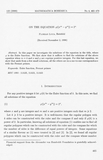Article
Full entry |
 PDF
(3.3 MB)
Feedback
PDF
(3.3 MB)
Feedback
 PDF
(3.3 MB)
Feedback
PDF
(3.3 MB)
Feedback
Keywords:
Euler function; Fermat primes
Euler function; Fermat primes
Summary:
In this paper we investigate the solutions of the equation in the title, where $\phi$ is the Euler function. We first show that it suffices to find the solutions of the above equation when $m=4$ and $x$ and $y$ are coprime positive integers. For this last equation, we show that aside from a few small solutions, all the others are in a one-to-one correspondence with the Fermat primes.
References:
[1] R. D. Charmichael: On the numerical factors of arithmetic forms $\alpha^n ± \beta^n$. Ann. Math. 15 (1913-1914), 30-70.
[2] F. Luca: Equations involving arithmetic functions of Fibonacci and Lucas numbers. Preprint. To appear in Fibo. Quart. MR 1738646 | Zbl 0941.11006
[3] F. Luca: Pascal's triangle and constructible polygons. Preprint, Zbl 1006.11004

